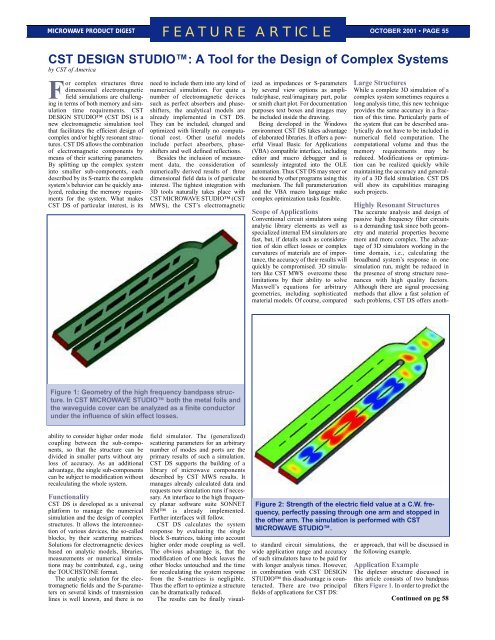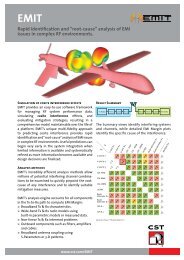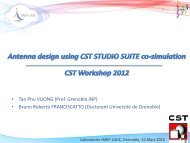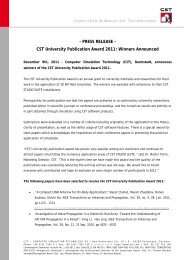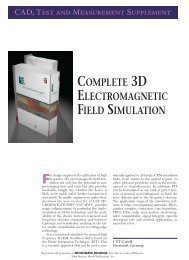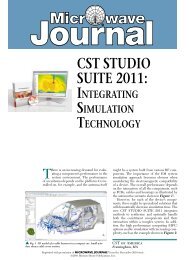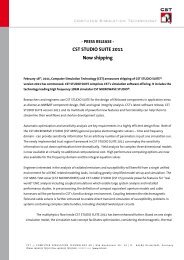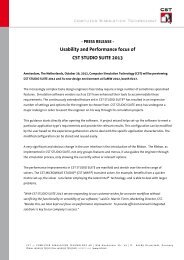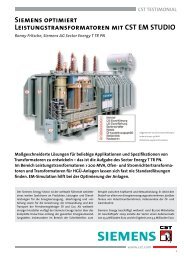Microwave Product Digest - CST
Microwave Product Digest - CST
Microwave Product Digest - CST
You also want an ePaper? Increase the reach of your titles
YUMPU automatically turns print PDFs into web optimized ePapers that Google loves.
MICROWAVE PRODUCT DIGEST OCTOBER 2001 • PAGE 55<br />
FEATURE ARTICLE<br />
<strong>CST</strong> DESIGN STUDIO: A Tool for the Design of Complex Systems<br />
by <strong>CST</strong> of America<br />
F<br />
or complex structures three<br />
dimensional electromagnetic<br />
field simulations are challeng-<br />
ing in terms of both memory and simulation<br />
time requirements. <strong>CST</strong><br />
DESIGN STUDIO (<strong>CST</strong> DS) is a<br />
new electromagnetic simulation tool<br />
that facilitates the efficient design of<br />
complex and/or highly resonant structures.<br />
<strong>CST</strong> DS allows the combination<br />
of electromagnetic components by<br />
means of their scattering parameters.<br />
By splitting up the complex system<br />
into smaller sub-components, each<br />
described by its S-matrix the complete<br />
system’s behavior can be quickly analyzed,<br />
reducing the memory requirements<br />
for the system. What makes<br />
<strong>CST</strong> DS of particular interest, is its<br />
ability to consider higher order mode<br />
coupling between the sub-components,<br />
so that the structure can be<br />
divided in smaller parts without any<br />
loss of accuracy. As an additional<br />
advantage, the single sub-components<br />
can be subject to modification without<br />
recalculating the whole system.<br />
Functionality<br />
<strong>CST</strong> DS is developed as a universal<br />
platform to manage the numerical<br />
simulation and the design of complex<br />
structures. It allows the interconnection<br />
of various devices, the so-called<br />
blocks, by their scattering matrices.<br />
Solutions for electromagnetic devices<br />
based on analytic models, libraries,<br />
measurements or numerical simulations<br />
may be contributed, e.g., using<br />
the TOUCHSTONE format.<br />
The analytic solution for the electromagnetic<br />
fields and the S-parameters<br />
on several kinds of transmission<br />
lines is well known, and there is no<br />
need to include them into any kind of<br />
numerical simulation. For quite a<br />
number of electromagnetic devices<br />
such as perfect absorbers and phaseshifters,<br />
the analytical models are<br />
already implemented in <strong>CST</strong> DS.<br />
They can be included, changed and<br />
optimized with literally no computational<br />
cost. Other useful models<br />
include perfect absorbers, phaseshifters<br />
and well defined reflections.<br />
Besides the inclusion of measurement<br />
data, the consideration of<br />
numerically derived results of three<br />
dimensional field data is of particular<br />
interest. The tightest integration with<br />
3D tools naturally takes place with<br />
<strong>CST</strong> MICROWAVE STUDIO (<strong>CST</strong><br />
MWS), the <strong>CST</strong>’s electromagnetic<br />
Figure 1: Geometry of the high frequency bandpass structure.<br />
In <strong>CST</strong> MICROWAVE STUDIO both the metal foils and<br />
the waveguide cover can be analyzed as a finite conductor<br />
under the influence of skin effect losses.<br />
field simulator. The (generalized)<br />
scattering parameters for an arbitrary<br />
number of modes and ports are the<br />
primary results of such a simulation.<br />
<strong>CST</strong> DS supports the building of a<br />
library of microwave components<br />
described by <strong>CST</strong> MWS results. It<br />
manages already calculated data and<br />
requests new simulation runs if necessary.<br />
An interface to the high frequency<br />
planar software suite SONNET<br />
EM is already implemented.<br />
Further interfaces will follow.<br />
<strong>CST</strong> DS calculates the system<br />
response by evaluating the single<br />
block S-matrices, taking into account<br />
higher order mode coupling as well.<br />
The obvious advantage is, that the<br />
modification of one block leaves the<br />
other blocks untouched and the time<br />
for recalculating the system response<br />
from the S-matrices is negligible.<br />
Thus the effort to optimize a structure<br />
can be dramatically reduced.<br />
The results can be finally visual-<br />
ized as impedances or S-parameters<br />
by several view options as amplitude/phase,<br />
real/imaginary part, polar<br />
or smith chart plot. For documentation<br />
purposes text boxes and images may<br />
be included inside the drawing.<br />
Being developed in the Windows<br />
environment <strong>CST</strong> DS takes advantage<br />
of elaborated libraries. It offers a powerful<br />
Visual Basic for Applications<br />
(VBA) compatible interface, including<br />
editor and macro debugger and is<br />
seamlessly integrated into the OLE<br />
automation. Thus <strong>CST</strong> DS may steer or<br />
be steered by other programs using this<br />
mechanism. The full parameterization<br />
and the VBA macro language make<br />
complex optimization tasks feasible.<br />
Scope of Applications<br />
Conventional circuit simulators using<br />
analytic library elements as well as<br />
specialized internal EM simulators are<br />
fast, but, if details such as consideration<br />
of skin effect losses or complex<br />
curvatures of materials are of importance,<br />
the accuracy of their results will<br />
quickly be compromised. 3D simulators<br />
like <strong>CST</strong> MWS overcome these<br />
limitations by their ability to solve<br />
Maxwell’s equations for arbitrary<br />
geometries, including sophisticated<br />
material models. Of course, compared<br />
to standard circuit simulations, the<br />
wide application range and accuracy<br />
of such simulators have to be paid for<br />
with longer analysis times. However,<br />
in combination with <strong>CST</strong> DESIGN<br />
STUDIO this disadvantage is counteracted.<br />
There are two principal<br />
fields of applications for <strong>CST</strong> DS:<br />
Large Structures<br />
While a complete 3D simulation of a<br />
complex system sometimes requires a<br />
long analysis time, this new technique<br />
provides the same accuracy in a fraction<br />
of this time. Particularly parts of<br />
the system that can be described analytically<br />
do not have to be included in<br />
numerical field computation. The<br />
computational volume and thus the<br />
memory requirements may be<br />
reduced. Modifications or optimization<br />
can be realized quickly while<br />
maintaining the accuracy and generality<br />
of a 3D field simulation. <strong>CST</strong> DS<br />
will show its capabilities managing<br />
such projects.<br />
Highly Resonant Structures<br />
The accurate analysis and design of<br />
passive high frequency filter circuits<br />
is a demanding task since both geometry<br />
and material properties become<br />
more and more complex. The advantage<br />
of 3D simulators working in the<br />
time domain, i.e., calculating the<br />
broadband system’s response in one<br />
simulation run, might be reduced in<br />
the presence of strong structure resonances<br />
with high quality factors.<br />
Although there are signal processing<br />
methods that allow a fast solution of<br />
such problems, <strong>CST</strong> DS offers anoth-<br />
Figure 2: Strength of the electric field value at a C.W. frequency,<br />
perfectly passing through one arm and stopped in<br />
the other arm. The simulation is performed with <strong>CST</strong><br />
MICROWAVE STUDIO.<br />
er approach, that will be discussed in<br />
the following example.<br />
Application Example<br />
The diplexer structure discussed in<br />
this article consists of two bandpass<br />
filters Figure 1. In order to predict the<br />
Continued on pg 58
PAGE 58 • OCTOBER 2001 FEATURE ARTICLE MICROWAVE PRODUCT DIGEST<br />
Continued from pg 55<br />
complete electromagnetic behavior<br />
including skin effect losses and curvatures,<br />
the highly developed features of<br />
a 3D simulation tool are required.<br />
Furthermore, a very fine discretization<br />
around the metal foils is indispensable,<br />
especially to accurately predict<br />
the passband’s edge frequencies.<br />
Therefore, more than a hundred thousand<br />
single mesh elements, considerably<br />
varying in size (high aspect ratio)<br />
are required in order to model the<br />
device accurately. Although the geometry<br />
looks quite simple, the electromagnetic<br />
complexity of this highly<br />
resonant system and the described<br />
mesh requirements qualify it as an<br />
ideal benchmark candidate for the<br />
comparison of simulation engines.<br />
Various simulation methods behave<br />
significantly differently with respect<br />
to the numerical effort, especially<br />
when attacking larger numbers of<br />
mesh elements. Implicit algorithms<br />
(e.g. all frequency domain methods)<br />
behave in a strongly non linear way<br />
(in terms of computer resources) with<br />
increasing problem sizes, whereas<br />
explicit algorithms such as the FDTD<br />
and FIT method can handle large<br />
problems within a reasonable memory<br />
size and time.<br />
The simulation of the complete<br />
diplexer using <strong>CST</strong> MWS, a simulator<br />
based on the Finite Integration (FI)<br />
method is shown Figure 2. The<br />
advantage of <strong>CST</strong> MWS compared to<br />
conventional time domain codes is the<br />
precise geometrical representation<br />
even of curved shapes, achieved<br />
by the Perfect Boundary<br />
Approximation (PBA). This<br />
Figure 4: S21 as a function of frequency. Due to its tight integration with <strong>CST</strong> MICROWAVE<br />
STUDIO, all advantages of this general purpose EM tool are maintained in <strong>CST</strong> DESIGN<br />
STUDIO. As shown, the pass band transmission is reduced by more than 0.5 dB when<br />
considering skin effect losses.<br />
method avoids staircase approximation<br />
of curved structures, without giving<br />
up any advantages of the explicit<br />
time integration algorithm. Despite<br />
the outstanding speed and memory<br />
efficiency of <strong>CST</strong> MWS, compared to<br />
other 3D EM Simulators on the market,<br />
the complete 3D simulation of the<br />
2-arm diplexer takes a few hours on a<br />
standard desktop PC, so that advanced<br />
design strategies, including parameter<br />
sweeping and optimization runs, are<br />
not practical.<br />
Technology<br />
At this point, the benefit of the new<br />
program <strong>CST</strong> DESIGN STUDIO<br />
becomes obvious: its ability to speed<br />
up the described simulation without<br />
losing accuracy. <strong>CST</strong> DESIGN STU-<br />
DIO reaches this goal by splitting<br />
up a complex system into smaller<br />
components, described by component<br />
S-matrices. Taking into account higher<br />
order modes in the S-matrix<br />
description, the structure can be dissected<br />
even at locations where the<br />
fundamental mode alone is not sufficient<br />
to describe the electromagnetic<br />
coupling accurately.<br />
Particularly for resonant structures<br />
the gain in simulation time can be dra-<br />
Figure 3: User Interface of <strong>CST</strong> DESIGN STUDIO. The diplexer is split into smaller sub-components.<br />
Taking into account higher order mode coupling between the components ensures<br />
highly accurate simulation results - more than 10 times faster, compared conventional 3D<br />
simulations.<br />
matic: the structure can be split up<br />
into non-resonant parts, which are<br />
then analyzed much faster than structures<br />
with multiple narrowly spaced<br />
resonances. In addition, time domain<br />
simulators such as <strong>CST</strong><br />
MICROWAVE STUDIO have the<br />
possibility of speeding up a simulation<br />
by increasing the simulation bandwidth,<br />
therefore using a shorter stimulation<br />
pulse. Finally the simulation<br />
time for the whole structure is reduced<br />
to couple of minutes.<br />
Summary<br />
<strong>CST</strong> DESIGN STUDIO is a new<br />
tool for the fast design of passive high<br />
frequency devices. Even highly resonant<br />
structures can be split into nonresonant<br />
sub-components.<br />
The new approach is capable of<br />
taking skin effect losses as well as<br />
arbitrary curved structures and<br />
boundaries into account. Since the<br />
simulation time is reduced significantly<br />
compared to conventional<br />
tools, <strong>CST</strong> DESIGN STUDIO now<br />
even allows fast full parameterization<br />
and optimization studies for complex<br />
systems, while maintaining all<br />
required accuracy.<br />
<strong>CST</strong> DESIGN STUDIO is a<br />
package of high functionality which<br />
interfaces to different simulators or<br />
even measurement data, so that each<br />
component can be analyzed with the<br />
simulator best suited to the particular<br />
component. Furthermore, analytic<br />
models and/or libraries are available,<br />
which again speeds up the daily<br />
design work.<br />
The intuitive and easy to use interface<br />
is based on the latest software<br />
technology Figure 3. This enables the<br />
user to build up clear schematic drawings<br />
of complex structures and circuits,<br />
keeping a clear overview by<br />
adding text and graphic elements.<br />
<strong>CST</strong> OF AMERICA<br />
CIRCLE READER SERVICE NO. 5


